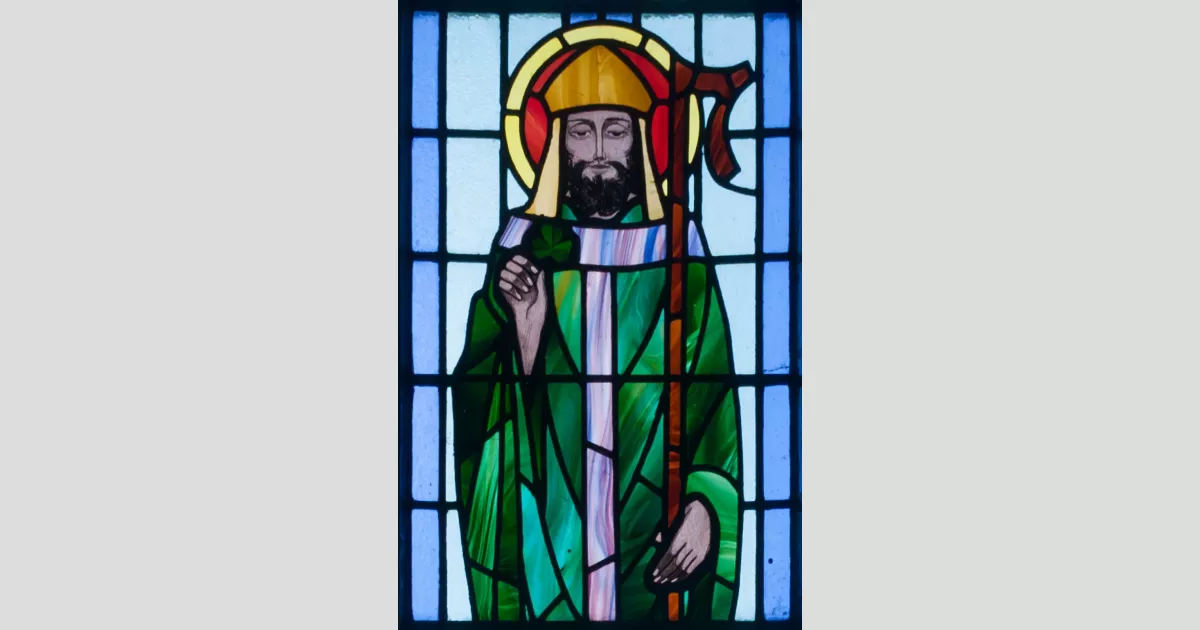Saint Patrick's Day, observed annually on March 17th, commemorates the traditional death date of Saint Patrick, the patron saint of Ireland. Originally a religious feast, it has evolved into a global celebration of Irish culture. Key aspects include parades, wearing green attire, shamrocks, Irish music and dance, and symbols of Irish heritage. Celebrations often involve consuming Irish food and beverages. While rooted in religious tradition, Saint Patrick's Day is now widely recognized as a secular holiday celebrating Irish identity and culture across the globe.
1901: Introduction of shamrock presentation to the Irish Guards
In 1901, Queen Alexandra introduced the tradition of the Royal Colonel presenting bowls of shamrock to members of the Irish Guards.
1903: First Saint Patrick's Day parade in Ireland
The first Saint Patrick's Day parade in Ireland was held in Waterford in 1903, during Irish Language Week. The parade included the Mayor, Waterford Corporation members, trade unions, and bands, commencing at the Gaelic League premises on George's St and concluding in the Peoples Park, where dignitaries addressed the public.
1916: Flags of the Easter Rising featured green
In 1916, flags of the Easter Rising featured green, such as the Starry Plough banner and the Proclamation Flag of the Irish Republic.
1916: Irish Volunteers hold St Patrick's Day parades
On Saint Patrick's Day in 1916, the Irish Volunteers held parades throughout Ireland; authorities recorded 38 parades with 6,000 marchers, about half of whom were armed.
1919: Toronto Maple Leafs renamed Toronto St. Patricks
In 1919, the Toronto Maple Leafs hockey team was renamed the Toronto St. Patricks and wore green jerseys to honor Saint Patrick's Day.
1921: Union Jack controversy at parade
In 1921, authorities in Victoria ordered a Union Jack be flown at the front of the Saint Patrick's Day parade, leading to refusal by Irishmen and Irish-Australians and subsequent assault on the flag bearer.
1922: Irish Free State post boxes painted green
In 1922, when the Irish Free State was founded, the government ordered all post boxes be painted green, with the slogan "green paint for a green people".
1924: Introduction of green Irish passport
In 1924, the government introduced a green Irish passport.
1925: St Patrick's Society of Selangor founded
In 1925, the St Patrick's Society of Selangor, which organizes a yearly St Patrick's Ball, was founded, and is described as the biggest Saint Patrick's Day celebration in Asia.
1926: End of Quebec City St-Patrick Parade
In 1926, the Quebec City St-Patrick Parade ceased after running from 1837.
1927: Alcohol sales banned on St Patrick's Day in the Irish Free State
In 1927, the Irish Free State government banned the selling of alcohol on St Patrick's Day.
1927: End of Toronto St. Patricks name
In 1927, the Toronto St. Patricks were renamed.
1929: United Irish Societies of Montreal organize Saint Patrick's Day parade
Since 1929, the United Irish Societies of Montreal has organized the yearly Saint Patrick's Day parade in Montreal, continuing a tradition that has been held without interruption since 1824.
1931: First official St Patrick's Day parade in Dublin
In 1931, the first official, state-sponsored Saint Patrick's Day parade in Dublin took place.
1940: Saint Patrick's Day observance moved
In 1940, Saint Patrick's Day was officially observed on April 3 to avoid coinciding with Palm Sunday.
1950: King George VI presents shamrocks to the Irish Guards
In 1950, King George VI presented bowls of shamrock to the Irish Guards to mark the 50th anniversary of their formation.
1952: Start of Shamrock Presentation Tradition
In 1952, the tradition began of the Irish Ambassador to the US sending a box of shamrocks to the US President (Harry S. Truman) for Saint Patrick's Day.
1955: End of Public Holiday Status in New Zealand
In 1955, Saint Patrick's Day ceased to be recognised as a public holiday in New Zealand, along with St George's Day and St Andrew's Day.
1961: Repeal of alcohol ban on St Patrick's Day
In 1961, the ban on selling alcohol on St Patrick's Day in the Irish Free State was repealed.
1976: Car bomb attack during St Patrick's Day celebration in Dungannon
In 1976, during the Troubles, loyalists detonated a car bomb outside a pub crowded with Catholics celebrating St Patrick's Day in Dungannon, resulting in four civilian deaths and many injuries.
1985: Orange Order holds Saint Patrick's Day parade
In 1985, the Orange Order held its own Saint Patrick's Day parade in Northern Ireland.
1994: Formalization of Shamrock Presentation Ceremony
In 1994, after the meeting between Taoiseach Albert Reynolds and President Bill Clinton, the presentation of shamrocks to the US President became a yearly custom.
March 1996: First Saint Patrick's Festival
The first Saint Patrick's Festival was held on March 17, 1996, as part of a government campaign to showcase Ireland and its culture.
1997: Saint Patrick's Festival becomes a three-day event
In 1997, the Saint Patrick's Festival became a three-day event.
1998: Cross-community St Patrick's Day parades in Northern Ireland
Since the end of the conflict in 1998, there have been cross-community St Patrick's Day parades in towns throughout Northern Ireland, attracting thousands of spectators.
1999: Toronto Maple Leafs wear green St Patrick's retro uniforms
In 1999, the Toronto Maple Leafs wore green St Patrick's retro uniforms for their game on Saint Patrick's Day.
1999: Shortest St Patrick's Day parade in Dripsey begins
In 1999, the shortest Saint Patrick's Day parade began in Dripsey, County Cork, lasting just 23.4 metres between two pubs.
2000: First Saint Patrick's Day parade in Oslo
Since 2000, Oslo, Norway has held a Saint Patrick's Day parade, first organized by Irish expatriates and partially coordinated with the Irish embassy.
2001: St Patrick's Day celebrations postponed due to foot-and-mouth outbreak
In 2001, public St Patrick's Day festivities in Ireland were postponed to May due to the foot-and-mouth outbreak.
2002: Inaugural Saint Patrick's Day parade in London
Since 2002, London has hosted an annual Saint Patrick's Day parade around March 17, typically in Trafalgar Square.
2004: Shortest St Patrick's Day parade in Hot Springs
In 2004, Hot Springs, Arkansas began hosting the shortest St. Patrick's Day parade since 2004, measuring at 98 feet.
2004: CelticFest Vancouver Society organizes first yearly festival
In 2004, the CelticFest Vancouver Society organised its first yearly festival in downtown Vancouver to celebrate the Celtic Nations and their cultures, including a parade near Saint Patrick's Day.
2006: Saint Patrick's Festival becomes a five-day event
By 2006, the Saint Patrick's Festival had expanded to a five-day event.
2006: Large Saint Patrick's Day Party in Buenos Aires
In 2006, Buenos Aires hosted a Saint Patrick's Day party in Reconquista street, drawing 50,000 people to the Irish pubs in the area. The Catholic Church and the Irish community did not participate in organizing the event.
2006: Melbourne festival cancelled
In 2006, Melbourne's Saint Patrick's Day festivals and parades were cancelled due to the Commonwealth Games being booked around the planned events.
March 2007: Call to reclaim St Patrick's Day as a church festival
In the March 2007 issue of The Word magazine, Fr Vincent Twomey voiced concern about the secularization of Saint Patrick's Day and called for it to be reclaimed as a church festival.
2007: First Saint Patrick's Day parade and festival in Glasgow
Glasgow has held a yearly Saint Patrick's Day parade and festival since 2007, reflecting its large Irish population.
2007: Melbourne parade cancelled
In 2007, Melbourne's Saint Patrick's Day festivals and parades were cancelled due to the Australian Grand Prix being booked around the planned events.
2008: Trafalgar Square fountains dyed green
In 2008, the water in the Trafalgar Square fountains was dyed green for Saint Patrick's Day.
March 2009: Calgary Tower Goes Green
In March 2009, the Calgary Tower changed its top exterior lights to green CFL bulbs for Saint Patrick's Day as part of Project Porchlight, representing environmental concerns. Approximately 210 lights were changed, saving the Calgary Tower some $12,000 and reducing greenhouse gas emissions by 104 tonnes.
2009: Record attendance at Saint Patrick's Festival
In 2009, more than 675,000 people attended the parade, and the festival saw almost 1 million visitors.
2010: Return of Quebec City St-Patrick Parade
In 2010, the Quebec City St-Patrick Parade returned after more than 84 years, with the New York Police Department Pipes and Drums as special guests.
2011: Catherine Coleman's Space Performance
On Saint Patrick's Day in 2011, Irish-American astronaut Catherine Coleman played a hundred-year-old flute and a tin whistle belonging to members of The Chieftains while aboard the International Space Station.
2012: Skyfest as the centrepiece of the Saint Patrick's Festival
From 2006 to 2012 the Skyfest formed the centrepiece of the Saint Patrick's Festival.
2012: "The Chieftains in Orbit" Released
In 2012, Catherine Coleman's 2011 performance in space was included in a track called "The Chieftains in Orbit" on The Chieftains' album, Voice of Ages.
2012: Duchess of Cambridge presents shamrocks to the Irish Guards
Since 2012, the Duchess of Cambridge has presented the bowls of shamrock to the Irish Guards.
2013: Chris Hadfield's Saint Patrick's Day in Space
On Saint Patrick's Day in 2013, Chris Hadfield took photographs of Ireland from Earth orbit, posted a picture of himself in green clothing in the space station, and shared a recording of himself singing "Danny Boy" online.
2014: Ban Lifted in New York City
In 2014, the ban on LGBTQ groups marching in New York City's Saint Patrick's Day parade was lifted, though barriers to participation remained.
2014: Campaign Against Negative Stereotypes
In the run up to Saint Patrick's Day 2014, the Ancient Order of Hibernians successfully campaigned to stop major American retailers from selling novelty merchandise that promoted negative Irish stereotypes, such as 'leprechaun outfits'.
2015: Sarajevo Irish Festival established
In 2015, the Sarajevo Irish Festival was established by the Irish expatriate community in Sarajevo, Bosnia and Herzegovina, and is held for three days around Saint Patrick's Day.
2016: Sydney parade cancelled
In 2016, Sydney's Saint Patrick's Day parade and family day were cancelled due to financial problems.
2016: Duke of Cambridge presents shamrocks to the Irish Guards
In 2016, the Duke of Cambridge presented the bowls of shamrock to the Irish Guards in place of his wife.
2017: Saint Patrick's feast day added to the Russian Orthodox Church calendar
In 2017, the Russian Orthodox Church added the feast day of Saint Patrick to its liturgical calendar, to be celebrated on March 30.
2019: Waterloo street party growth
Since 2019, the City of Waterloo, Ontario has had to contend with an ever-growing massive street party that has coincided with the Saint Patrick's Day celebrations.
2020: Brisbane Parade Held Despite Pandemic
In 2020, Brisbane's Saint Patrick's Day parade was not cancelled due to the COVID-19 pandemic, unlike many other parades around the world.
2020: St Patrick's Day celebrations cancelled due to COVID-19 pandemic
In 2020, public St Patrick's Day festivities in Ireland were cancelled due to the COVID-19 pandemic.
2020: Cancellation of London parade due to COVID-19
In 2020, the Saint Patrick's Day parade in London was cancelled due to the COVID-19 pandemic.
2021: St Patrick's Day celebrations cancelled due to COVID-19 pandemic
In 2021, public St Patrick's Day festivities in Ireland were cancelled due to the COVID-19 pandemic.
2021: Irish UN Peacekeepers Celebrate in Syria
In 2021, the United Nations Disengagement Observer Force's Irish contingent led a Saint Patrick's Day parade in Syria, where members received shamrocks and 35 personnel were presented with the UN Peacekeeping Medal.
2022: Shortest St Patrick's Day parade in Little Compton
In 2022, the current shortest Saint Paddy's Day parade has been held in Little Compton, Rhode Island which lasts only 89 feet.
2023: Increased security measures for Waterloo street party
In 2023, police put up fences on Ezra Avenue in Waterloo to discourage participation in the unauthorized Saint Patrick's Day street party, which costs the city up to $750,000 a year for police, paramedics, and municipal services.
Mentioned in this timeline

Bill Clinton the nd U S President - served as...
New Zealand is an island country located in the southwestern...
Japan is an East Asian island country situated in the...

Fireworks are pyrotechnic devices primarily utilized for entertainment and aesthetic...
Australia officially the Commonwealth of Australia encompasses the Australian mainland...
Korea is a peninsular region in East Asia comprised of...
Trending
3 months ago Colorado I-70 Traffic Gridlock: Georgetown Reopens After Leaf-Peeping Blockade and Delays.

27 days ago Joseph Quinn's 'Stranger Things' impact, 'Master of Puppets' fame, and 'Pillion' BIFA win.

26 days ago Sabrina Carpenter slams Trump White House for using 'Juno' in ICE video.

2 months ago Della Maddalena Praised Makhachev, Pimblett Favors Him; Bisping Sees Warm-Up Fight

Coldplay is a British rock band formed in London in comprising Chris Martin Jonny Buckland Guy Berryman and Will Champion...
4 months ago Lord Huron Concert Scenes and Horizon Hits with Shinedown and Gabby Barrett
Popular

XXXTentacion born Jahseh Dwayne Ricardo Onfroy was a controversial yet...

Stranger Things created by the Duffer Brothers is a popular...
The Kennedy Center Honors are annual awards recognizing individuals and...

Candace Owens is an American conservative political commentator and author...
Turning Point USA TPUSA is an American nonprofit organization founded...

William Franklin Graham III commonly known as Franklin Graham is...
